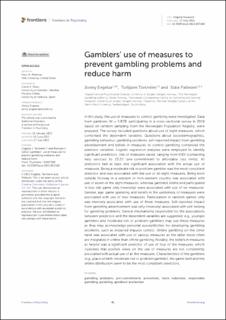| dc.description.abstract | In this study, the use of measures to control gambling were investigated. Data from gamblers (N = 5,878) participating in a cross-sectional survey in 2019 based on random sampling from the Norwegian Population Registry, were analysed. The survey included questions about use of eight measures, which comprised the dependent variables. Questions about sociodemographics, gambling behaviour, gambling problems, self-reported impact from gambling advertisement and beliefs in measures to control gambling comprised the predictor variables. Logistic regression analyses were employed to identify significant predictors. Use of measures varied, ranging from 0.8% (contacting help services) to 23.2% (pre-commitment to affordable loss limits). All predictors had at least one significant association with the actual use of measures. Being a moderate risk or problem gambler was the most consistent predictor and was associated with the use of all eight measures. Being born outside Norway in a western or non-western country was associated with use of seven of the eight measures, whereas gambled online and participated in low-risk game only (inversely) were associated with use of six measures. Gender, age, game spending and beliefs in the usefulness of measures were associated with use of four measures. Participation in random games only was inversely associated with use of three measures. Self-reported impact from gambling advertisement was only (inversely) associated with self-testing for gambling problems. Several mechanisms responsible for the associations between predictors and the dependent variables are suggested, e.g., younger gamblers and moderate risk or problem gamblers may use these measures as they may acknowledge personal susceptibilities for developing gambling problems, such as impaired impulse control. Online gambling on the other hand was associated with use of various measures as the latter more often are integrated in online than offline gambling. Notably, the beliefs in measures as helpful was a significant predictor of use of four of the measures, which illustrates that positive views on the use of measures are not consistently associated with actual use of all the measures. Characteristics of the gamblers (e.g., place of birth, moderate risk or problem gambler), the game itself and the online distribution seem to be the most consistent predictors. | en_US |

